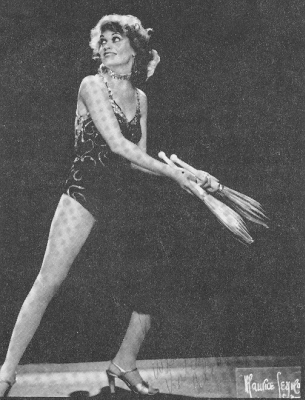
Katia Alcarese |
Dale Jones |
oiiPage 10 March 1982
|
Katia
Alcarese Beginning
in high heels
Katia
Alcarese plans to join the Osmani Sisters juggling troupe this
summer. For several years, she has performed a solo act, appearing
at the Plaza Hotel in New York City and receiving help with
choreography from Lottie Brunn last summer. The
story of her development into a professional at age 20 holds lessons
for other men and women to note.
"But
I've found something out about rehearsing for an act. It's that you
need character and theme more than technical juggling. I've worked
on other things, like dance and theatre, for up to five months
without juggling in the past, and it has given my act more
personality and grace," she said.
The
Alcarese style is a combination of dance and classical juggling, a
performance in high heels and sequins. Balancing tricks are an
important part of her act. At the 1979 IJA convention in Amherst,
she demonstrated the ability to balance a pencil on her nose, then
sit down on the floor and roll over, rising again with the pencil
still perched in position.
She
is one of a mere handful of professional female jugglers in the IJA,
and seems to be building a strong career. Dale
Jones Working around a twist of fate
Writing
about Dale Jones, you have to point out his handicap first, because of
the remarkable way in which he's worked around it to become a
successful performer. "I
hurt my right arm when I was eight and had a lot of surgery on
it," said the 25-year old St. Louis, MO, resident. "It fused
my wrist and thumb and I can only move the first two fingers. I can't
grip a ball with my right hand. "
The
crippled arm, stymied in its growth, would seem to prevent most
juggling. But just read the description of Jones' performance in the
U.S. Nationals competition at the Cleveland convention, and you'll
find it doesn't seem to have hindered his ability a bit:
"Political
puns with three balls and a tennis racket. Three in one hand. Two
tennis rackets in one hand under the leg. Triple spin of tennis racket
to hand balance catch. Foot balance. Hat and cane manipulation. Cane
from foot balance kicked up to chin balance. Three nested cups. Two
balls in one hand, play bugle. Thunderous applause. No drops. "
The
crowd at Cleveland voiced disapproval of Jones' low finish - seventh
place - and he, too, admitted to some chagrin. But Jones went to his
first IJA convention to collect ideas rather than prizes. "I
haven't been disappointed in that aspect of it at all," he said.
"My
style has definitely been influenced by my handicap," Jones
explained. "I learned to juggle two in my left hand at age 14,
but was all onehanded for four years. Everyone would ask me if I
could do three, and I was determined to figure out a way. It wasn't
until I started doing two tennis rackets in one hand that I got it.
First, I tried to get a normal cascade going between three balls in my
left hand, bouncing them off the tennis racket I held in my right
hand. But I couldn't catch the thrown balls softly enough on the
racket. Finally I figured out this multiplex pattern that works great,
and I've developed a lot of variations for it, too."
The
unique multiplex move appears quite natural on stage. Viewers often
don't notice that his right hand is barely functional. He depends on
his wit to carry a large part of the show also.
The
versatility of his juggling and precision of his balance tricks made
Jones an instant IJA favorite. His creativity and cheerful ability to
accommodate a harsh twist of fate make him an inspiration as well. |

Katia Alcarese |
Dale Jones |